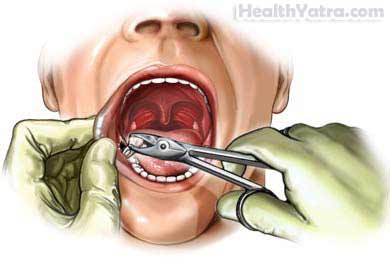সংজ্ঞা
This is a procedure to remove a tooth.

পদ্ধতির কারণ
While dental techniques can save many teeth, a tooth may need to be removed if it:
- Is too badly damaged or decayed to be saved by a root canal
- Has an infected nerve
- Is affecting normal tooth growth
- Is loose from advanced gum disease
- Has a loss of supporting bone, gums, or tissue
সম্ভাব্য জটিলতা
Complications are rare, but no procedure is completely free of risk. If you are planning to have a tooth extracted, your dentist will review a list of possible complications, which may include:
- রক্তপাত
- সংক্রমণ
- নার্ভ ক্ষতি
জটিলতার ঝুঁকি বাড়াতে পারে এমন কারণগুলির মধ্যে রয়েছে:
- ধূমপান
- কম পুষ্টি উপাদান
- দরিদ্র সামগ্রিক স্বাস্থ্য
- Use of some prescription and non-prescription drugs—Talk to your dentist about any medicine you are taking.
Be sure to discuss these risks with your dentist before the procedure.
কি আশা করা যায়
পদ্ধতির আগে
Your dentist will likely:
- Do a thorough dental exam
- Do an x-ray of the mouth—a test that uses radiation to take a picture of structures inside the body, especially bones
এনেস্থেশিয়া
Depending on the procedure, your dentist will choose:
- Local anesthesia—just the area that is being operated on is numbed; given as an injection
- General anesthesia —blocks pain and keeps you asleep through the procedure
পদ্ধতির বর্ণনা
If the tooth is impacted (buried in the gum), the dentist will remove the overlying gum tissue to expose the tooth. Using forceps, the dentist will grasp the tooth and gently rock it back and forth. This action will loosen the tooth and break the ligaments that hold the tooth in place. The tooth will be pulled, and a blood clot will form in the empty socket. The dentist will pack a gauze pad into the socket. In some cases, the dentist will place a few stitches to close the gum edges.
অবিলম্বে প্রক্রিয়া পরে
You will need to bite firmly but gently on the gauze pad. This will reduce bleeding and permit a clot to form in the tooth socket. If rapid bleeding continues, replace with a fresh pad every 20-30 minutes. Otherwise, leave the pad in place for 3-4 hours.
কতক্ষণ এটা লাগবে?
It often takes about 20 minutes but may take longer for impacted teeth.
এটা কতটা আঘাত করবে?
You will feel pain in your jaw. Your dentist may give you pain medicine.
পোস্ট-প্রক্রিয়া যত্ন
যখন আপনি বাড়িতে ফিরে, একটি মসৃণ পুনরুদ্ধার নিশ্চিত করতে সাহায্য করার জন্য নিম্নলিখিতগুলি করুন:
- To reduce swelling, apply an ice pack to the area. Apply for 10 minutes at a time.
- Do not dislodge the blood clot that forms in the wound. Do not spit or rinse forcefully in the first 24 hours.
- ধূমপান করবেন না.
- Do not allow food particles to pack into the socket.
- Do not use drinking straws in the first 24 hours.
- Begin rinsing your mouth 24 hours after the procedure. Use a solution made of ½ teaspoon salt and 8 ounces warm water.
- Eat a soft or liquid diet for the first 24 hours.
- Avoid activity for the first 24 hours. For the next 1-2 days, limit your activity.
- Continue to brush and floss other teeth. This will help prevent infection in the extraction site.
- আপনার ডাক্তারের নির্দেশাবলী অনুসরণ করতে ভুলবেন না।
In the first 24 hours, expect some swelling and bleeding. The initial healing period usually takes about 1-2 weeks. New bone and gum tissue will grow into the gap.
Having a missing tooth can lead to shifting teeth, improper bite, or difficulty chewing. Your dentist may attempt to restore the area with an implant, fixed bridge, or denture.
Call Your Dentist
After arriving home, contact your dentist if any of the following occurs:
- জ্বর এবং ঠাণ্ডা সহ সংক্রমণের লক্ষণ
- Redness, swelling, increasing pain, or any discharge from the open socket
- Excessive bleeding continuing for more than four hours after surgery
- ব্যথা যা আপনি ওষুধ দিয়ে নিয়ন্ত্রণ করতে পারবেন না
- কাশি, শ্বাসকষ্ট, বুকে ব্যথা, বা তীব্র বমি বমি ভাব বা বমি
- কোনো নতুন উপসর্গ
জরুরী পরিস্থিতিতে, অবিলম্বে চিকিৎসা সহায়তার জন্য কল করুন।
